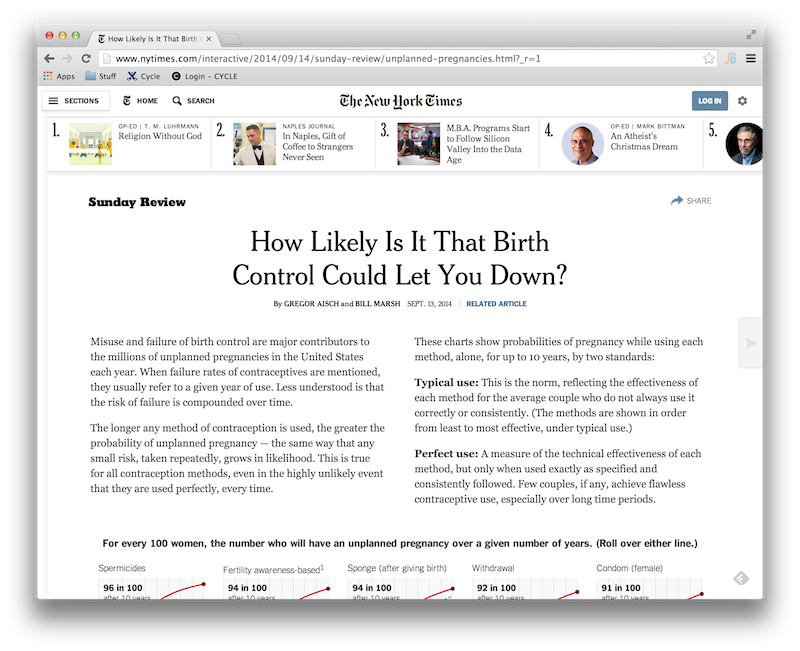Birth Control Stats
Back in Advent, the New York Times listed the failure rates of the different kinds of artificial contraceptives. People are often distrustful of stats produced quoted by religious authorities, so I thought I’d post this secular source here so I can find it again later when the subject of contraception comes up:
I’m really quite impressed with the New York Times. Not only is the webpage is nicely produced with interactive graphics, it also lists the effectiveness of various methods both with Perfect Use and, more importantly, Typical Use.

Very interesting but the left of NFP. I wonder what the statistics are for those using NFP?
I’d say NFP is a very different beast and doesn’t really fit into the same category as artificial contraceptives.
I’ve heard that it’s “success” rate is very high, but I don’t actually really like it when people try and sell NFP on its “efficiency” for several reasons, not least of which is that some couples use NFP in order to get pregnant, rather than to avoid it!
However, because it is based on abstention, it can be as efficient as you want it to be – it just depends on how much padding you want to put around the fertile periods during a woman’s cycle.
I’m confused – unless you mean something different by NFP, it’s right there in the article.
They call it “Fertility awareness-based” (Ovulation method) – and it’s worse than male condoms at preventing unplanned pregnancies, even with perfect use.
It’s not necessarily the same thing, NFP is broader.
I’m also not hugely sure how they’d pull statistics for this since those who follow those kinds of methods don’t typically want to postpone having children indefinitely, but rather to space them out and would use the method in order to conceive, as well as to avoid conception.
I know it’s broader in that it can be used to conceive too, but that doesn’t affect its efficacy if the goal is to not conceive.
They say at the bottom how they got the statistics: they’re just taking p(y) = p(1) ^ y where p = probability of no unplanned pregnancy, and y = years. I.e. they extrapolated it all from the probabilities for one year.
Not only in that sense, but also in the techniques of tracking the ovulation cycle.
A former roommate once told me that her parents were using one form of birth control when her oldest brother was conceived, a different type when her second brother was conceived and yet a third form of birth control when her mom became pregnant with her. I don’t remember which three forms those were, but if any of them had worked properly, none of them would be here now.
So, to quote “Jurassic Park,” “Life finds a way.” 🙂
Well, quite…
Nice!
I agree with you that NFP is a different beast and doesn’t fit into the same category as artificial contraceptives but the study did include the “withdrawal” method, which is not a artificial (but is still sinful from a Catholic POV). I suppose I shouldn’t complain. Most of the time the media calls NFP the “rhythm method,” which bugs me to no end.
I’ve heard that when used properly NFP is 99% effective in either postponing or achieving pregnancy. One of the beautiful things about being always open to life is that you are always open to life. No such things as a “surprise” pregnancy because you are always open to the gift that is life.